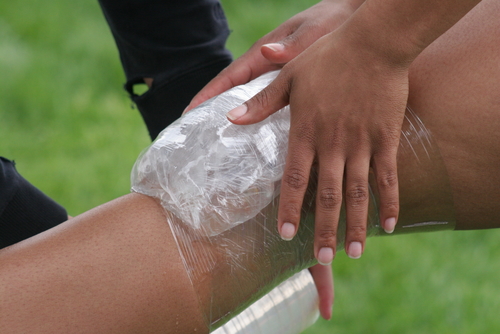How To Deal With Soft Tissue Injuries

Sometimes you’ll see an athlete huffing and puffing on the pitch, despite the fact that he has just crashed into a 250lbs monster. Some might call it as the adrenaline rush, and the normal reaction is to move around to shake it off.
As the muscle is heated up from all the activities performed on the court, the athlete can easily ignore the injury. However, as he continued to perform at his maximal effort, this is only going to exacerbate the injury and keep him out of the game for a prolonged period.
While injuries are considered as part of the game, the extent of injury can be greatly minimized if immediate treatment were properly applied.
Immediate Treatment
The easiest way to alleviate the pain off the injured area is by applying ice onto it. Ice reduces the sensitivity of the nerves and relieves swelling and pain. It also helps in reducing the incidence of muscle spasms and blood flow towards the injured area.
Athlete is required to move the injured area around slowly after cooling it down with an ice pack. The general population has the misconception that immobilization is the best way to treat such injury, but this method is actually much more effective in treating athletic injuries. This technique of cooling down the injured area with ice followed by light exercises is called cryokinetics.
Light exercise after an injury speeds up the muscle’s ability to regain the function of moving with a full range of motion. For example, cryokinetic treatment for wrist injury involves ice compression, wrapping the wrist with elastic bandage, and elevating the arm followed by a series of range of motion exercises.
Keep in mind that applying ice onto the injured area won’t make all the pain go away; it’s used to help in the healing process and prevent the injury from getting worse.

Type of Ice Treatment
There are 3 types of ice treatment:
- Ice massage,
- Ice bath, and
- Ice pack.
The ice massage is often used to cool down a particular muscle group. Water is frozen in a Styrofoam or paper cup, which is torn back for about an inch at the upper half of the cup, so that the ice can be used to rub against the injured area.
Massage the injured area anywhere from seven to twenty minutes, or until you started to feel numb. Use a small towel to hold the cup while you’re rubbing the injured area so that it won’t numb your fingers.
Commonly seen during sports events, ice pack is readily available for the treatment of acute injuries. Have a towel handy and put the ice pack inside, followed by applying the towel directly onto the injured area.
The great thing about ice packs is that they can be used immediately without the need to prepare beforehand. Breaking the container inside the pack creates a low temperature environment that lasts for 20 to 30 minutes.
Ice bath is effective in treating distal body parts injuries. It’s commonly used during the recovery stage to accelerate healing process and reduce inflammation.
Prepare enough ice cubes to fill in about half of the basin or pail with cold water. Immerse the injured body part in it and keep it there for less than 10 minutes. Anytime longer than that will risk frostbite.
Heat Treatment
Heat modality is another effective method that can be used in later stage of recovery. It’s used to help increase blood circulation and relax the muscles. As it promotes blood flow rather than reducing it, you should only consider using this technique after the swelling is gone.
Some of the heat therapies available include hot packs, baths, ultrasound, whirlpool, and hot water bottles. The hot bath or whirlpool can be done by most people at home. Water temperature should be kept warm rather than heated, or you may risk yourself from getting burned.
Ultrasound treatment is also used in physical therapy. It delivers heat to injured tissues by using high to low frequency sound waves.

